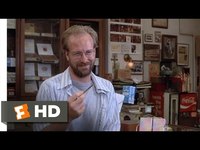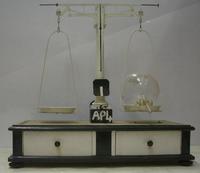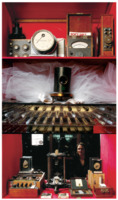Items
Site
The Medicine Chest
keywords is exactly
physics
-

Weighing Smoke
PAUL That’s the man. Well, Raleigh was the person who introduced tobacco in England, and since he was a favourite of the Queen’s – Queen Bess, he used to call her – smoking caught on as a fashion at court. I’m sure Old Bess must have shared a stogie or two with Sir Walter. Once, he made a bet with her that he could measure the weight of smoke. DENNIS You mean, weigh smoke? PAUL Exactly. Weigh smoke. TOMMY You can’t do that. It’s like weighing air. PAUL I admit it’s strange. Almost like weighing someone’s soul. But Sir Walter was a clever guy. First, he took an unsmoked cigar and put it on a balance and weighed it. Then he lit up and smoked the cigar, carefully tapping the ashes into the balance pan. When he was finished, he put the butt into the pan along with the ashes and weighed what was there. Then he subtracted that number from the original weight of the unsmoked cigar. The difference was the weight of the smoke. TOMMY Not bad. That’s the kind of guy we need to take over the Mets. PAUL Oh, he was smart, all right. But not so smart that he didn’t wind up having his head chopped off twenty years later. (Pause) But that’s another story. -

Weighing Air
An example from demonline (UCT Physics Department’s website with descriptions of educational demonstrations). Its descriptions reads: "A spherical flask of about 1 litre is suspended from one arm of a crude chemical balance. It is counterpoised by weights in the other pan, the tap attached to the sphere being open. This gives (roughly) the true weight of the glass. Unhook the sphere from the stirrup, attach the rubber tube from a rotary vacuum pump to the glass tube and evacuate for around 30s. Close tap, and re-attach stirrup. There will now be an upthrust on the flask equal to the weight of air removed, and the weights in the other pan will have to be reduced by about 1.2 g to restore the balance. Open the tap again: the air can be heard rushing into the flask (class must keep quiet), and the flask suddenly descends again". -

Lodestone
An example from demonline (UCT Physics Department’s website with descriptions of educational demonstrations). Its description reads: ‘A lodestone is suspended by a string. Show that it rotates on bringing a magnet near it. Dip it into iron filings and show that it picks them up.’ -

Capitance
"Strategies such as juxtapositioning also served to highlight poetic and emotive qualities in fields not known for encouraging them, as in a cabinet curated by Langerman titled Capitance. This featured a range of instruments from the Physics department used to measure electrical currents (galvanometers, capacitors and Wheatstone bridges); a crystal goniometer measuring crystal face angles and crystal 175 from the crystal collection in Geological Sciences; M.R. Drennan’s models of the human embryo and a wax model of flesh; and a white tutu from the School of Ballet. In combining this selection of scientific instruments with a tutu, Langerman made allowance for the materials to be considered in a more poetic light, inviting the viewer to consider how a grand jeté defies the laws of physics, for example" (Liebenberg 2021: 186). -

Resonance (Greenblatt)
In 'Resonance and Wonder' Greenblatt discusses ‘resonant’ moments in regards to museum displays as “those in which the supposedly contextual objects take on a life of their own and make a claim that rivals that of the object that is formally privileged. A table, a chair, a map – often seemingly placed only to provide a decorative setting for a grand work – become oddly expressive, significant not as a background but as compelling representational practices in themselves. These practices may in turn impinge on the grand work, so that we begin to glimpse a kind of circulation: the cultural practice and social energy implicit in mapmaking is drawn into the aesthetic orbit of a painting, which has itself enabled us to register some of the representational significance of the map” (1991: 22- 23). For him a resonant exhibition often “pulls the viewer away from the celebration of isolated objects and toward a series of implied, only half-visible relationships and questions” (1991: 23). -

Resonance
Image from page 137 of the 'Curiosity CLXXV' catalogue, describing resonance and its application in MRI technology. -

Breath Sculptures
In the exhibition, 'Chest: a botanical ecology', "this cabinet extended the ideas of fragility and fallibility represented by the broken glass laboratory bottle, displaying four ‘breath sculptures’ made by the five individual breaths of children who suffer from asthma: Thaakira Salie (aged 8), Ziyaad Small (aged 10), Blake Leppan (aged 9) and Jessie Allot (aged 11). Working in collaboration with the Allergy Foundation of South Africa and Andre de Jager, UCT’s resident glass blower in the Department of Chemistry, I facilitated a workshop in which the children were taught the practice of blowing glass and then produced their own sculptures by breathing into molten glass. The breath sculptures made by these children were far removed from the functional bespoke glassware usually produced in the workshop for chemical experiments or for those conducted for physics and chemical engineering (A. de Jager, personal communication, 20 August 2018)" (Liebenberg 2021: 263). -

Einstein's abstracts
Cibachrome on aluminium. Microscopic magnification of Einstein’s equations from a blackboard that had been preserved in the History of Science Museum in Oxford -

Breath of a Physicist
William Blake, 1794, Ancient of Days Inscription: "In his hand, he took the Golden Compasses, prepared in Gods Eternal stone, to circumscribe This Universe, and all created things One foot he center'd, and the other turn'd Round through the vast profundity obscure, And said, thus farr extend, thus far thy bounds, This be thy just circumference, O World" "In the process of realising this work, [Cornelia] Parker facilitated the collaboration of scientists from the physics department with those from its art gallery. She also drew attention to the scientific qualities of the artwork and, through the performative act of igniting a firework display, the symbolism of scientific discovery" (Liebenberg 2021: 31). -

Graphene
"Parker formulated 'Breath of a physicist' while engaging with the academic communities of the University of Manchester in 2015. She worked closely with the scientists of the institution, most notably Kostya Novoselov, who, with Andre Geim, was awarded the Nobel Prize for the discovery of graphene – the world’s thinnest and strongest material. After being inspired by the discovery of a graphite drawing by William Blake ('The ancient of days') in the university’s art collection, Parker facilitated a collaboration between the gallery staff and Novoselov in which he sourced microscopic samples of graphite from the drawing, as well as graphite from drawings by Turner, Constable and Picasso and from a pencil-written letter by Sir Ernest Rutherford (who split the atom in Manchester), which all formed part of the university’s collections. Novoselov produced graphene from these samples, which Parker then used to make her own artwork and a ‘Blake-graphene sensor’, which was activated by the breath of a physicist (Novoselov) and set off a firework display, returning iron meteorite into the Manchester sky on the opening night" (Liebenberg 2021: 31).


